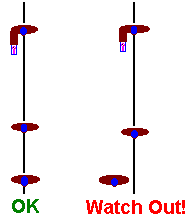Illustrated Tutorial On How To Use a Compass, page 4
I said navigating in the mountains is easier. Well that is until the fog comes. Fog can make orienteering in the mountains and in the forest extremely difficult, and therefore, it can also be dangerous to the unexperienced. The principles of orienteering are still the same, but there are a few hints in the next lesson that will help you get trained.
How To Navigate In Foggy Conditions
Fog makes things difficult, and in some situations dangerous. When you hike, you will probably some day experience these difficulties, and you would better be prepared. The fog can come creeping very fast. I have myself experienced from clear view to dense fog in 10 seconds. How fast this goes, depends on where you are.
In normal summer conditions without snow, it is often not much of a problem. Unless you are supposed to find a hut or something. The ground provides normally so much contrast, you could do the aiming I have written about in lesson 2. Just be very careful and accurate. Perhaps you also might use some of the advice given later.
Winter conditions can make things a lot worse, when there is snow on the ground. The fog is white (or grey), the snow is also white. You may get a condition we call a "white-out."
It is too late to read the terrain, and then the map is not of much use. You cannot see anything anyway. You have no choice but to put blind faith in your compass. I hope you knew where you were, because you need to take out a good compass course, like described in the other lessons.
If you are skiing, you should tie your compass to your arm or something, so you can look at it for every step you take. A rubberband is good. Check for more or less every step you take that the compass needle is aligned with the orienting lines.
But if it is cold, make sure it does not affect circulation of blood in your arm, because that will make you freeze. If you are going on an expedition where you expect conditions like this, you should perhaps consider a arrangement to attach to your chest.
Let's consider a method to enhance the accuracy in conditions when you cannot aim at anything.
Three Persons In a Row

If you are three persons in a row, like on the figure, and the last one carries a compass (of course, it is better that all three carry a compass, but the last one has command), he or she will see if you get off course because one of those in front of him or her will not be covered by the person in front.
On the figure, the situation to the left is ok. The person on top is heading forward and but he sees only the person in front of him or her. In the situation to the right, it is time to stop. The last person can see the backs of both of them in front, and they are about to leave their course.
The further apart you go, the more accurate this method is, but it is also very important to have good contact. Sometimes the conditions get so bad there is no way to maintain contact, and then, the method may fail.
There is also another method for two people, where the lead person goes out on a compass azimuth, as far as the visibility will allow. The person behind stands still and watches the lead person, telling them if they are in the correct line or not.
Once they have moved correctly into line they then stand still and the back person joins them. They then have their turn to move out ahead on the azimuth, and the whole cycle repeats. The problem with this method is when the visibility is very bad, the lead person cannot go more that a few meters, and it would be dangerous to loose each other.
Finally, I would like to comment on something that is seen in many standard texts on mountaineering navigation: You are commonly taught to use methods that use terrain features that are easily recognizable but far away. In my opinion, such methods are of little use, unless you require surveyor's accuracy in knowing where you are (hikers rarely do).
As long as the weather is good, navigation is fairly easy and you'll naturally use these features as part of a more general approach. However, when the visibility is poor, you cannot see these far-away-features and this makes the methods involving them rather useless. Therefore, focus your training in navigation on using features in your vicinity.